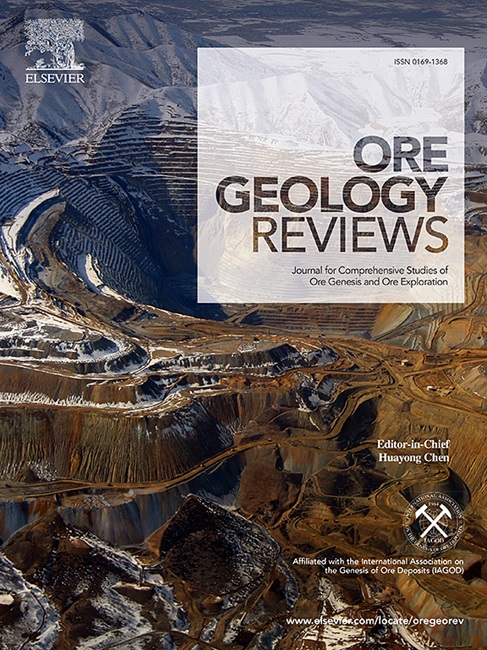Molybdenite Re-Os and zircon U-Pb geochronology, Lu-Hf isotope and geochemistry constraints on the genesis of the Jinxi Cu deposit, southern Fujian, South China
IF 3.2
2区 地球科学
Q1 GEOLOGY
引用次数: 0
Abstract
The Jinxi Cu deposit, situated on the southeastern margin of the Cathaysian Plate within the Shanghang-Yunxiao tectonic-magmatic metallogenic belt, is a medium-sized deposit discovered in the region in recent years. This study employs molybdenite Re-Os and zircon U-Pb dating, along with Lu-Hf isotopic and whole-rock geochemical analyses, to elucidate the rock-forming and ore-forming processes, as well as the genesis of the Jinxi deposit. The results show that the granodiorites related to mineralization in the mining area belong to the high-potassium calc-alkaline series, characterized by high K2O levels, low SiO2, and low TiO2 concentrations. Analysis of rare earth elements (REE) and trace elements reveals that the granodiorites are enriched in light rare earth elements (LREE) and exhibit weak negative Eu anomalies. Integrating these findings with evidence from related research, the granodiorites of the Jinxi Cu deposit can be reasonably classified as I-type granites. Zircon Laser Ablation Inductively Coupled Plasma Mass Spectrometry (LA − ICP − MS) dating of the granodiorites yields an age of 104.2 ± 0.4 Ma. The zircon εHf(t) values for the granodiorites range from −2.49 to 1.58, with two-stage model ages (TDM2) ranging from 1.08 to 1.32 Ga. Re − Os isotopic dating of molybdenite samples yields an isochron age of 104.6 ± 3.7 Ma for the ore bodies, indicating that the formation of the Jinxi Cu deposit during the late Yanshanian period is primarily associated with the emplacement of intrusive rocks. Integrating field observations, wall-rock alteration characteristics, geochronological data, and isotopic analyses, the Jinxi deposit is identified as a high- to medium-temperature magmatic-hydrothermal vein-type copper deposit. The formation of the Jinxi granodiorite and its associated mineralization is attributed to the subduction of the Paleo-Pacific Plate along the southeastern coastal region during the late Early Cretaceous period (110–90 Ma).

闽南金溪铜矿成矿的辉钼矿Re-Os和锆石U-Pb年代学、Lu-Hf同位素及地球化学约束
金溪铜矿位于华夏板块东南缘上杭—云霄构造—岩浆成矿带内,是近年来在该地区发现的中型矿床。利用辉钼矿Re-Os和锆石U-Pb定年、Lu-Hf同位素和全岩地球化学分析,阐明了金溪矿床的成岩成矿过程和成因。结果表明,矿区与成矿有关的花岗闪长岩属高钾钙碱性系列,具有高K2O、低SiO2、低TiO2的特征。稀土元素及微量元素分析表明,花岗闪长岩富集轻稀土元素(LREE),呈现弱Eu负异常。结合相关研究成果,金西铜矿花岗闪长岩可合理划分为i型花岗岩体。锆石激光烧蚀电感耦合等离子体质谱(LA - ICP - MS)测定花岗闪长岩年龄为104.2±0.4 Ma。花岗闪长岩的锆石εHf(t)值为−2.49 ~ 1.58,两阶段模式年龄(TDM2)为1.08 ~ 1.32 Ga。辉钼矿样品的Re - Os同位素定年结果表明,等时线年龄为104.6±3.7 Ma,表明燕山晚期金溪铜矿的形成主要与侵入岩侵位有关。综合野外观测、围岩蚀变特征、年代学资料及同位素分析,确定金西矿床为中高温岩浆热液脉状铜矿床。晋西花岗闪长岩的形成及其成矿作用是在早白垩世晚期(110-90 Ma)古太平洋板块沿东南沿海的俯冲作用下形成的。
本文章由计算机程序翻译,如有差异,请以英文原文为准。
求助全文
约1分钟内获得全文
求助全文
来源期刊

Ore Geology Reviews
地学-地质学
CiteScore
6.50
自引率
27.30%
发文量
546
审稿时长
22.9 weeks
期刊介绍:
Ore Geology Reviews aims to familiarize all earth scientists with recent advances in a number of interconnected disciplines related to the study of, and search for, ore deposits. The reviews range from brief to longer contributions, but the journal preferentially publishes manuscripts that fill the niche between the commonly shorter journal articles and the comprehensive book coverages, and thus has a special appeal to many authors and readers.
 求助内容:
求助内容: 应助结果提醒方式:
应助结果提醒方式:


